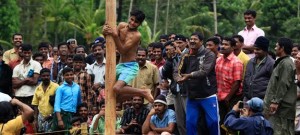This year’s edition of Wayanad Splash – a genuine effort to promote rain tourism – takes off on July 12. Be there if serious off-roading, dirt biking or mud football floats your boat. And yes, business will meet business too.
‘It’s like the human brain. We know it but we don’t know it.’ This was Mr Joseph, in-charge of the Meteorological Centre, Trivandrum, explaining the state’s monsoon phenomenon in Alexander Frater’s ‘Chasing the monsoon.’ Now, how do we make sense of something we do not understand? Stop trying and celebrate it! The Wayanad Tourism Organisation (WTO) is bang on here with Wayanad Splash, touted as South India’s only monsoon carnival, which has entered its fifth edition this year.
“Splash was started five years ago not just to fill up (hospitality) properties during the lean period but to make everybody see the beauty of the season which is typically labelled ‘off’ in tourism parlance,” says Vancheeswaran, secretary of WTO. “Though we had to go through a lot of difficulties to convince locals of the potential of the festival, today we are well on our way into hearts in foreign and far away shores.” At the core of all efforts was the firm conviction that Wayanad was not a high-volume destination but a fragile region whose resources had to be conserved, heritage preserved and traditions observed and respected. Recent archaeological findings point to human inhabitation in the rich Wayanad forests from over 3,000 years. “Eventually the discerning traveller as well as a growing responsible tourism market will weed out the exploitative forces and those misusing sensitive destinations,” believes Vancheeswaran. Verdant Wayanad (etymologically from the words ‘vayal’ meaning ‘paddy field’ and ‘naadu’ meaning ‘land’ or country, making it the ‘land of paddy fields’) in north-east Kerala is the 12th district of the state formed in 1980 putting together areas of Kannur and Kozhikode districts. The lush region is steeped in history and has been centre of action for many warring monarchs and dynasties: Hyder Ali from Mysore annexed it from Pazhassi Raja before it fell into the hands of Tipu Sultan who, eventually, was forced to surrender it to the British. With the English, the whole area got a facelift – forests were cleared for tea plantations and other cash crops like cocoa, pepper and vanilla. Improved connectivity and job prospects saw people from all over the south migrating and settling down as plantation workers. Many from the indigenous adivasi or tribal population joined this burgeoning workforce while most moved farther and deeper into the forests and the mountains; even today Wayanad has the highest adivasi density – at over 30 per cent of the total population – in the state. The lush Western Ghats embroidering the district is responsible for its salubrious climate. But rampant deforestation has raised its ugly head which could soon turn into an environmental crisis. One hopes the growing success of Splash will instil in those responsible for the destruction the sense that harmonious coexistence with a fragile ecosystem eventually has its own rewards – including monetary. The calamitous consequence of mindless exploitation leading to a skewed progress is all around us today. Resting cosily on the southern tip of Deccan plateau, the pristine beauty of Wayanad lures the traveller in you; Splash is the irresistible bait for the action junkie. For the off-roading and skill driving competitions organised jointly by the Jeep Club of Wayanad and WTO the organisers expect participation of around 100 vehicles. The contests are classified under different categories of SUVs, modified jeeps, Gypsies and quad bikes. The rainforest track in nearby Vythiri will witness the off road action on July 13, Saturday, followed by the skill drive competition in a closed circuit the next day. Cash prizes and trophies will be distributed among the winners. Slated to be a harbinger of sorts of adrenaline-charged events in the state, the competitions will be covered by regional and local television channels and other media. Upping the gaiety quotient are also some quirky, original contests like paddy planting, catching the crab, climbing a slippery tree and of course, the heavily attended mud football. Then, all play and no work makes a carnival, well, just another carnival? “It was more of merrymaking till last year and this year we hope to focus on the market as well – to invigorate the economy,” says Vancheeswaran. There is an added thrust to b2b meets this year: Expected to attend the festival are 400 tour and travel operators from across the state and country who will interact with hospitality property owners. The organisers are realistic when it comes to expectations and results and have given themselves another two years before seeing any significant rise in visitor numbers. In addition to those who got together for the fun and frolic, last year’s edition saw some scholarly discussions on different aspects of responsible tourism and its impact on Wayanad. There were, of course, fractious discords on action plans, way forwards and takes on sustainability were as discrepant and disconcerting as an ageing political ideologue’s attempts at reinventing a fast fading relevance. But one thing everyone across boards agreed was that ‘responsible’ was the only way forward for tourism in the super sensitive ecosystem that is Wayanad.All photographs are courtesy of the Splash website. Please visit the festival website for more details.
While at Wayanad
The Thirunelli Temple on the foothills of the Brahmagiri with its 30 granite pillars is a tribute to classical Kerala architecture. If you are visiting this temple to Lord Vishnu, take a dip in the Papanashini stream that runs here which promises to wash away your sins.
The Edakkal caves, famous for its pre historic carving, is just 30km from Kalpetta (the district headquarters which is the main venue of the event), at Ambalavayal. Roaming around Ambalavayal – a pristine agrarian setting – is calming in itself.
Muthanga Wildlife Sanctuary is on the way from Sulthan Bathery, also near Kalpetta, to Mysore. Spot elephants, bison, wild deer and an occasional tiger here.
Go for a boat ride on the crystal clear waters of the Pookote Lake.
Nearby Vythiri has many fantastic accommodation options including tree houses which make for great rain watching. However, a trek through the jungle at this time of the year is not suggested for the blood-thirsty leaches. Or if you do, arm yourself with a lot of tobacco powder or salt – these insistent suckers find their way in even over tall boots.















